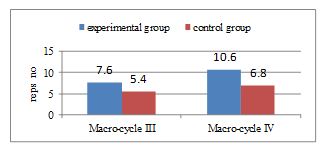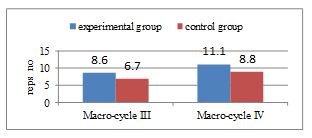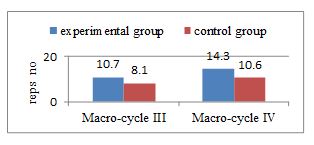Abstract
The aim of this paper is to improve the monitoring of complete training through effective use of control and planning in the development of female gymnasts’ motor skills within an Olympic training cycle. An experimental study was made to this end in all micro-, mezzo- and macro-cycles of the four-year training cycle. The study revealed the increase of complex motricity when achieving high sports performances. During this research, 14 parameters were tested to determine the gymnasts’ motor training while evaluating their progression too. The comparative analysis results showed significant differences between the experimental group subjects. These results were compared with each other during macro-cycles of the 2nd, 3rd and 4th training year. There were also highlighted significant differences between the results obtained by the experimental group subjects who carried out their activity according to the developed models and the control and planning system strategy and the results obtained by the subjects in the control group where these developments were not applied. The analysis of performances obtained by the two groups monitored during their motor training highlighted significant results of the experimental group, with a probability of P < 0.05 as for the calculation of the difference between statistical indicators tested in the first macro-cycle and data obtained in the second macro-cycle of the Olympic cycle. The application of the control and planning system for motor skill development provided useful information for the safe and effective monitoring of the full training of gymnasts under research.
Keywords: Gymnasticstestingmonitoringmotor trainingperformance
Introduction
Athletic training is a long-lasting adaptation process carried out over several years; thus, its effective guidance can be achieved only based on the scientific provision of the sets of objectives, decisions and means. The structure of the training is represented by its content organized in components of different dimensions and correlated according to the requirements imposed by the body adaptation meant to develop the capacity for performance and implicitly the specific fitness. Training structure includes the multi-annual structure (one or two Olympic cycles), macro-structure (annual or multi-annual), mezzo-structure (average duration), micro-structure (system of sessions) and the training session (Nicu, 1993; Planotov, 2015).
For that purpose, the planning process should be kept within longer or shorter strategies, concretised in programs with different extensions in terms of the number of factors taken into account. We consider the Olympic cycle or the four-year plan as a segment of long-term planning. There are two methodological approaches for the organization and planning of the Olympic cycle (mono-cyclic and bi-cyclic). An Olympic cyclic plan may follow the similar features of an annual plan as a retrospective where the coach analyses the dynamics of athlete’s physical development, the results in competitions, the tests and standards for each factor of the training (Bompa, 2002).
The annual and macro-cycle training plans are the first forms of the planning, in which the training programs are materialised. The conditions for carrying out a training plan raise the issue of the existence of the activity of development, achievement and control of the training process. The control of the training consists in comparing the result with the intended goal, modifying certain elements of the training.
Physical training, a component of athletic training, puts a mark on the entire process of training and determines athletes’ performances both in training sessions and competitions. It provides an increased functional capacity of the body through the high development of the specific motor skills, abilities and capacities, of the optimal values of morphofunctional indicators, the accuracy of exercise execution and the health status (Dragnea & Teodorescu-Mate, 2002; Platonov, 2015).
Motor skills can be defined by the set of fundamental components met by sports performance; they are also the materials for constructing the motor performances of each athlete (Simion, Mihăilă, & Stănculescu, 2011).
Out of the bio-motor skills, the strength and power are the most critical ones for many sports. In the case of elite athletes, the relationship of increasing strength, velocity and endurance - bio-motor qualities that play a determining role and are more difficult to develop - depends on the particularities of the sport and its needs (Bompa, 2002).
Problem Statement
Nowadays, artistic gymnastics has recorded important progress, demonstrating that it develops according to the trends of performance sport, but it also has its specific characteristics among which the most important are the increase in sports mastery and the improvement of the components required by the training of high-ranking female gymnasts (Arkaev & Suchilin, 2004).
The ultimate goal of gymnastics training is to achieve the highest sports results, which are also the main “engine” of gymnastics development. The creation of a training program for a certain period is an important stage that requires modelling the main quantitative and qualitative indicators of the training content in conformity with gymnasts’ level and the duration of the proposed training cycle. Modelling must optimally focus on all parameters that contribute to the achievement of the intended objectives. We must observe that, from one Olympic cycle to another, the aim is to increase the characteristics of the real models and indicators of the specific training of elite gymnasts (Vieru, 1997; Grigore, 2001; Niculescu, 2003; Arkaev & Suchilin, 2004).
In the theory and methodolgy of sports training, there are 5 basic components for the training of athletes: technical, tactical, physical, psychological and theoretical (Dragnea & Teodorescu-Mate, 2002; Platonov, 2015).
Lately one can notice the tendency to highlight the functional training as a separate (independent) part. Moreover, there are differences in training mentioned in the theory and methodology of gymnastics, such as: acrobatic, choreographic (artistic), centralised, pre-competitive, competitive and intermountain (at altitude) training etc. (Arkaev & Suchilin, 2004; Gaverdovskij, 2014). The physical and technical training are the main points of support through which the axis of full training of highly-skilled gymnasts passes.
The control and evaluation of training is a mandatory requirement for each coach and also an important factor in checking the developed program and making the binding corrections if necessary. The control and analysis underlying the evaluation of training are an element of dynamisation of the training process and a condition of the progress as well (Vieru, 1997).
The training plans for different durations are developed based on the previous data of the training mentioned in the records. The entire strategy of prognosis, programming and planning must rely on rigorous records including the exact dosing of the work to be performed, the conditions for its carrying out, the effects produced and the dynamics envisaged for the final analysis (Niculescu, 2003).
The establishment of accurate or even individualised test events and norms to be accomplished both physically and technically within a certain period is a pedagogical requirement with stimulating effect on the training and settlement of the intermediate objectives that lead to the completion of the annual training plan. The physical training in artistic gymnastics can be found out according to the following sequence: general physical training (preparatory period, basic stage), specific physical training (pre-competitive stage) and development of the specific motor skills which must be maintained at a high level (competitive period) (Vieru, 1997; Buftea, 2013; Potop, 2014).
The control and planning of the activities for the development and formation of the complex of female gymnasts’ motor skills involved reports on certain levels of training that an elite gymnast must reach, taking into account the stages, periods, some case situations and also the internal and external conditions of the training process. All these were achieved during the micro-, mezzo- and macro-cycles of the four-year cycle (Buftea, 2016).
Research Questions
To achieve the research, we proposed the following tasks:
To make the comparative analysis of subjects’ physical training indicators between groups and within groups in the macro-cycles of years II, III and IV of gymnasts’ training.
To use special exercises on gymnastics apparatus for strength-endurance, strength-speed and mobility in strength conditions by changing the volume of exercises and work guidance.
Does the application of the control and planning system to the activities for the complex development of motor skills underlying the sports training provide useful information for the safe and effective monitoring of the full training of gymnasts, as subjects of the research?
Purpose of the Study
The purpose of the study is to improve the monitoring of complete training through the effective use of control and planning in the development of female gymnasts’ motor skills within an Olympic training cycle.
Research Methods
In order to improve the monitoring of female gymnasts’ full training during an Olympic cycle, a pedagogical experiment was conducted in all micro-, mezzo- and macro-cycles of the four-year training cycle, revealing an increase in the complex motricity degree required to achieve high sports performance.
The following methods were used during this research: bibliographic study on the theoretical-conceptual, methodological and practical fundamentals presented in the specialised scientific and methodical literature; study of the documentary materials; method of specific tests; pedagogical experiment; statistical-mathematical method; graphical representation of data.
The pedagogical experiment was carried out from 2013 to 2016 within “Speranţa” Sports Club of Chisinau, with two research groups (experimental, n=10 and control, n=10) made up of athletes aged 12 to 15 years, members of the national team of the Republic of Moldova. The ascertaining experiment was conducted during the macro-cycle I, competitive year 2013. Throughout the macro-cycles II, III and IV, competitive years 2014-2016, basic training periods and pre-competitive stage, it was carried out the formative experiment, when the training programs were implemented only in the experimental group by monitoring the development of a single motor skill or the work on the apparatus – combined and complex – by the coaches of the club supervised by the author of this paper (himself coach at this club).
A number of 14 parameters were tested to evaluate the complex motricity during this research. Most of the physical training tests aimed at: the capacity of speed on a distance of 20 m, the strength of upper limbs, abdominal muscles and back muscles, the capacity of strength under speed conditions, mounting by stretched handstand, power handstand from straddled standing on the floor and rope climbing without leg support.
Findings
The results of the comparative analysis of female gymnasts’ motor skill testing during the macro-cycles I and II of the Olympic cycle in terms of development and evaluation of the 14 tested parameters highlighted that, by differentiating the results of the experimental and control groups, there were found out insignificant differences in the initial stage (index of P < 0.05 in all types of testing). This approach influenced the entire investigative study, contributing to the enhancement of subjects’ training according to the provisions of the developed strategy, in which the factors of the training process control and planning intensified the development of the complex of necessary skills depending on the concrete objectives of each training subject. Analysing the share of the performances obtained in the motor training by the two examined groups, one finds out that the experimental group has significant results with a probability of P < 0.05 at the calculation of the difference between the statistical indicators tested over the first macro-cycle and the data obtained during the second macro-cycle of the Olympic cycle.
The majority of physical training test events focus on: speed capacity on the 20-m distance, strength of upper limbs, abdominal and spinal muscles, inclusively strength capacity under speed conditions, mounting by stretched handstand, piked hanging position on bar, where it was noticed an increase from an average of 4.10 up to 6.40 reps (t = 3.09; P < 0.05). It was not observed a significant increase while testing the power handstand from straddled bent standing position on the floor and the rope climbing without leg support for 10 seconds (P > 0.05). These skills develop relatively slower than the explosive strength used in jumps and coordination (Romberg test and Matorin test), where the probability is significant (P < 0.01-0.001).
Table
The comparison of the results obtained by the experimental group and the control group reveals the existence of significant differences in the physical training during the third and fourth macro-cycles of the Olympic cycle in favour of the experimental group, with a probability of P < 0.01-0.001 in 11 test events and a probability of P < 0.05 in 3 tests.
Various methods were used depending on the objectives to be achieved in the respective macro-cycles. These methods aimed to develop a single skill or several motor skills in special cases of combined and complex character. Thus, the method of “isotonic” contractions, the method of “isometric” contractions and intermediate contractions as well (on the floor, uneven bars and rib stall) were used for the development of muscle strength, performing specific elements from the difficulty groups C-H. The method of training with intervals was applied to develop endurance by executing special connections of competitive elements and repeating them several times with a rest period of 60 sec. at the most. The “circuit training” (work on 5-6 stations) was used for the simultaneous and complex development of several motor skills. The number of stations was increased depending on the effort necessary for performing the exercise.



According to these indicators, the exercises applied for motor skill development were oriented toward the formation of specific motor skills and abilities. Performance was achieved by selecting the exercises aiming at the development of those muscle groups that participated in the execution of the technical element, taking into consideration the concordance between the biomechanical laws of exercise technique and the morphofunctional particularities of the body in concrete situations. An intensive increase was observed at arm bending and unbending from handstand on low bar - 73.54% (test 5, Figure
Conclusion
We revealed the increase of exercise volume, strictly controlled working conditions, change of muscle strength character in the training stage, maximum strain of the neuromuscular system in the phases of stress lowering and muscular system recovery by using special exercises on gymnastics apparatus for strength-endurance, strength-speed and mobility under strength conditions.
The comparative analysis of the obtained results shows significant differences found in the subjects of the experimental group (these results were compared to each other in the macro-cycles of the second, third and fourth year of gymnasts’ training) and significant differences between the results obtained by the subjects of the experimental group (who carried out their activity according to the developed models and the control and planning system strategy) and the subjects of the control group, where these developments were not applied.
In conclusion, the application of the control and planning system to the activities for the complex development of motor skills underlying the sports training has always provided useful information for the safe and effective monitoring of the full training of gymnasts, as subjects of the research.
Acknowledgments
This case study is an advanced stage of the pedagogical experiment of the post-doctoral thesis. We express our gratitude to the Gymnastics Federation of the Republic of Moldova and especially to the coaches of the local and abroad sports clubs who helped us to conduct this research.
References
- Arkaev, L. J., & Suchilin, N. G. (2004). Kak gotovit’ chempionov. Teorija i tehnologija podgotovki gimnastov vyshej kvalifikacii (pp. 78-79, 102-113, 127-161). Moscow: Fizkul'tura i Sport.
- Buftea, V. (2013). Didactica gimnasticii: Manual (Vol. I). Chisinau: USEFS.
- Buftea, V. (2016). The characteristics of control forms in the training of elite gymnasts. The International Scientific Congress “Sport. Olympism. Health” (Vol. II, pp. 17-21). Chisinau: USEFS.
- Bompa, T. O. (2002). Periodizare: Teoria şi metodologia antrenamentului sportiv (pp. 123-126, 269-287). București: Ex Ponto.
- Dragnea, A., & Teodorescu-Mate, S. (2002). Teoria sportului (pp. 429-438, 452-488). București: FEST.
- Grigore, V. (2001). Gimnastica artistică. Bazele generale ale antrenamentului sportiv (pp. 9-24). București: Semne.
- Nicu, A. (1993). Antrenamentul sportiv modern. București: Editis.
- Niculescu, G. (2003). Gimnastica artistică. Repere teoretice şi metodice (pp. 32-46, 125-145). București: Arvin.
- Platonov, V. N. (2015). Sistema podgotovki sportsmenov v olimpijskom sporte. Obschaja teorija i e practicheskoe primenenija. Kiev: Olimpijskaja Literatura.
- Potop, V. (2014). Teoria şi practica în gimnastica artistică (pp. 34-39, 49-58). București: Discobolul.
- Simion, Gh., Mihăilă, I., & Stănculescu, G. (2011). Antrenamentul sportiv. Concept systemic (pp. 73-122). Constanţa: Ovidius University Press.
- Vieru, N. (1997). Manual de gimnastică sportivă (pp. 37-44, 79-87). București: Driada.
Copyright information

This work is licensed under a Creative Commons Attribution-NonCommercial-NoDerivatives 4.0 International License.
About this article
Publication Date
05 March 2018
Article Doi
eBook ISBN
978-1-80296-035-8
Publisher
Future Academy
Volume
36
Print ISBN (optional)
-
Edition Number
1st Edition
Pages
1-484
Subjects
Sports, sport science, physical education, health psychology
Cite this article as:
Buftea, V. (2018). Control and Planning in the Development of Female Gymnasts’ Motor Skills. In V. Grigore, M. Stanescu, & M. Paunescu (Eds.), Physical Education, Sport and Kinetotherapy - ICPESK 2017, vol 36. European Proceedings of Social and Behavioural Sciences (pp. 184-191). Future Academy. https://doi.org/10.15405/epsbs.2018.03.24

